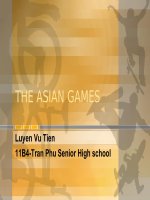12 the suzuki reaction
Bạn đang xem bản rút gọn của tài liệu. Xem và tải ngay bản đầy đủ của tài liệu tại đây (1.22 MB, 13 trang )
Myers
Chem 115
The Suzuki Reaction
Reviews:
Analysis of Elementary Steps in the Reaction Mechanism
Suzuki, A. J. Organometallic Chem. 1999, 576, 147–168.
Oxidative Addition
Br
Suzuki, A. In Metal-catalyzed Cross-coupling Reactions, Diederich, F., and Stang, P. J., Eds.; WileyVCH: New York, 1998, pp. 49-97.
Br
Pd0Ln
L
isomerization
Pd L
PdII Br
L
Miyaura, N.; Suzuki, A. Chem. Rev. 1995, 95, 2457-2483.
L
trans
cis
B-Alkyl Suzuki reaction:
Chemler, S. R.; Trauner, D.; Danishefsky, S. J. Angew. Chem., Int. Ed. Engl. 2001, 40, 4544–4568.
Solid phase:
Franzén, R. Can. J. Chem. 2000, 78, 957–962.
• Relative reactivity of leaving groups: I – > OTf – > Br – >> Cl –.
• Oxidative addition is known to proceed with retention of stereochemistry with vinyl halides and with
inversion with allylic or benzylic halides.
Stille, J. K.; Lau, K. S. Y. Acc. Chem. Res. 1977, 10, 434–442.
• The Suzuki reaction is the coupling of an aryl or vinyl boronic acid with an aryl or vinyl halide
or triflate using a palladium catalyst. It is a powerful cross-coupling method that allows for the
synthesis of conjugated olefins, styrenes, and biphenyls:
• Oxidative addition intially gives a cis complex that rapidly isomerizes to its trans isomer.
Casado, A. L.; Espinet, P. Organometallics 1998, 17, 954–959.
Transmetallation
n-Bu
B O
O
+
n-Bu
benzene/NaOEt
Br
80 ˚C, 4 h
B(OR)2
98%
n-Bu
Miyaura, N.; Suzuki, A. J. Chem. Soc., Chem. Commun. 1979, 866–867.
L2Pd
Mechanism:
X
Ph
Path B
n-Bu
X
Ar
L2Pd
H
n-Bu
B
H
OR
Ph
PhL2Pd
B(OR)2
+
n-Bu
O
OR
OR
R
Ph Br
Pd0L
Oxidative Addition
n
Reductive Elimination
Ph
n-Bu
EtO
L2Pd
n-Bu
RO–
+
B(OR)3–
+
Path A
B
O
n-Bu
PdIILn
Ph
PdIILn
Br
NaOEt
Ph
PdIILn
EtO
B O
O
NaBr
Transmetallation
O
+
L
O
n-Bu
L
PdII
EtO B
O
• Organoboron compounds are highly covalent in character, and do not undergo transmetallation
readily in the absence of base.
• The base is postulated to serve one of two possible roles: reaction with the organoboron reagent to
form a trialkoxyboronate which then attacks the palladium halide complex (Path A), or by
conversion of the palladium halide to a palladium oxo complex that reacts with the neutral
organoboron reagent (Path B).
Matos, K.; Soderquist, J. A. J. Org. Chem. 1998, 63, 461–470.
Carrow, B.P.; Hartwig, J. F. J. Am. Chem. Soc. 2011, 133, 2116–2119.
Suzuki, A. Pure & Appl. Chem. 1985, 57, 1749–1758.
Andrew Haidle, Chris Coletta, Eric Hansen
1
Reductive Elimination
L
• The conditions shown on the left are the original conditions developed for the cross-coupling by
Suzuki and Miyaura.
n-Bu
L PdII
L
• The reaction is stereo- and regiospecific, providing a convenient method for the synthesis of
conjugated alkadienes, arylated alkenes, and biaryls.
n-Bu
n-Bu
PdII
+ Pd0Ln
L
cis
trans
• Note that under the conditions shown above, aryl chlorides are not acceptable substrates for the
reaction, likely due to their reluctance to participate in oxidative addition.
a
• Isomerization to the cis complex is required before reductive elimination can occur.
• Relative rates of reductive elimination from palladium(II) complexes:
aryl–aryl > alkyl–aryl > n-propyl–n-propyl > ethyl–ethyl
>
methyl–methyl
Miyaura, N.; Suzuki, A. Chem. Rev. 1995, 95, 2457-2483.
Catalyst and ligands
Conditions
R BY2
n-Bu
P(PPh3)4
X R'
+
R R'
benzene, 80 ºC
Ph
Br
B O
O
base
time (h)
yield (%)
NaOEt
2
80a
NaOEt
2
80a
NaOEt
2
81a
NaOEt
2
100b
Ph
Br
CH3
Br
CH3
I Ph
Br Ph
Cl Ph
Miyaura, N.; Yamada, K.; Suzuki, A. Tetrahedron Lett. 1979, 20, 3437–3440.
Miyaura, N.; Suzuki, A. J. Chem. Soc., Chem. Commun. 1979, 866–867.
c Miyaura, N.; Yanagi, T.; Suzuki, A. Synth. Commun. 1981, 11, 513–519.
d Miyaura, N.; Yano, T.; Suzuki, A. Tetrahedron Lett. 1980, 21, 2865–2868.
b
• The most commonly used system is Pd(PPh3)4, but other palladium sources have been used
including PdII pre-catalysts that are reduced to the active Pd0 in situ:
• Pd2(dba)3 + PPh3
• Pd(OAc)2 + PPh3
• PdCl2(dppf) (for sp3-sp2 couplings-see section on B-alkyl Suzuki reaction)
• "Ligand-free" conditions, using Pd(OAc)2, have also been developed. Side reactions often
associated with the use of phosphine ligands (phosphonium salt formation and aryl-aryl exchange
between substrate and phosphine) are thus avoided.
Goodson, F. E.; Wallow, T. I.; Novak, B. M. Org. Synth. 1997, 75, 61–68.
N
63b
98b
NaOEt
NaOEt
2
4
NaOEt
2
3b
NaOEt
4
93b
H3C
CH3
H3C
N
CH3 H3C
1
H3C
CH3
N
CH3
+
N
Cl–
CH3 H3C
2
H3C
CH3
H3CO
Br
(HO)2B
+
I Ph
2M NaOH
6
62c
Br Ph
2M Na2CO3
6
88c
Cl Ph
NaOEt
6
0c
2M NaOH
2
87d
2M NaOH
2
99d
B(OH)2
n-Bu
H3C
Br
Cl
Pd2(dba)3 (1.5 mol%),
2 (3 mol%), Cs2CO3
H3C
dioxane, 80 ºC, 1.5 h
96%
• The nucleophilic N-heterocyclic carbene 1 is the active ligand, and is formed in situ from 2.
• The use of ligand 1 allows for utilization of aryl chlorides in the Suzuki reaction (see the section on
bulky, electron-rich phosphines as ligands for use of aryl chlorides as coupling partners as well).
B
Br
Zhang, C.; Huang, J.; Trudell, M. L.; Nolan, S. P. J. Org. Chem. 1999, 64, 3804-3805.
Andrew Haidle, Chris Coletta, Fan Liu
2
Organoboranes: A variety of organoboranes may be used to effect the transfer of the organic coupling
partner to the reactive palladium center via transmetallation. Choice of the appropriate organoborane
will depend upon the compatibility with the coupling partners and availability (see section on synthesis
of organoboranes).
N-methyliminodiacetic acid (MIDA) Boronates
• This trivalent boron protecting group attenuates transmetallation, and is unreactive under
anhydrous coupling conditions (see example below).
• Some of the more common organoboranes used in the Suzuki reaction are shown below:
R B(OH)2
H3C N
O
R B(OiPr)2
B O
O
R B
O
R
B
R B
O
O
O
O
CH3
CH3
EtO B
B O
O
K3PO4, THF, 65 oC
PCy2
Br
CH3
CH3
H3C N
p-Tol-B(OH)2
Pd(OAc)2
O
O
H3C
• MIDA boronates are stable to chromatography but are readily cleaved under basic aqueous
conditions:
• Use of Aryltrifluoroborates as Organoboranes for the Suzuki Reaction
H3C N
BF3K
Br
OCH3
Pd(OAc)2, K2CO3
OCH3
R
CH3OH, reflux
2h, 95%
• The aryltrifluoroborates are prepared by treatment of the corresponding arylboronic acid with
excess KHF2.
• According to the authors, aryltrifluoroborates are more robust, more easily purified, and less prone
to protodeboronation compared to aryl boronic acids.
B O
O
O
O
1M NaOH, THF
10 min
OH
B
OH
R
aq. NaHCO3
MeOH, 3.5 h
Gillis, E. P.; Burke, M. D. J. Am. Chem. Soc. 2007, 129, 6716-6717.
Gillis, E. P.; Burke, M. D. J. Am. Chem. Soc. 2008, 130, 14084-14085.
• Many unstable boronic acids, such as 2-heteroaryl, vinyl and cyclopropyl, form bench-stable MIDA
complexes.
• "Slow release" of boronic acid allows effective coupling of these substrates.
Molander, G. A.; Biolatto, B. J. Org. Chem. 2003, 68, 4302–4314.
OtBu
Solvent: The Suzuki reaction is unique among metal-catalyzed cross-coupling reactions in that it can
be run in biphasic (organic/aqueous) or aqueous environments in addition to organic solvents.
Casalnuovo, A. L.; Calabrese, J. C. J. Am. Chem. Soc. 1990, 112, 4324–4330.
H3C N
S
B O
O
O
O
Ot-Bu
Cl
Pd(OAc)2, SPhos
K3PO4, dioxane, water
60 oC, 6 h
S
94%
(Yield from the corresponding boronic acid: 37%)
Knapp, D. M.; Gillis, E. P.; Burke, M. D. J. Am. Chem. Soc. 2009, 131, 6961-6963.
Andrew Haidle, Chris Coletta, Eric Hansen
3
Bulky, Electron-Rich Phosphines as Ligands for the Suzuki Reaction
TlOH and TlOEt as Rate-Enhancing Additives for the Suzuki Reaction
TBSO
OTBS
OTBS
TBSO
I
OTBS
OTBS
OTBS
+
TBSO
O
(HO)2B
OTBS
OTBS
R
(H3C)2N
P(t-Bu)3
R = PCy2 (1)
R = P(t-Bu)2 (2)
OTBS
OTBS
OTBS
OCH3
O
Cy2P R
R'
TBSO
OTBS
R
P(Cy)3
R = PCy2 (3)
R = P(t-Bu)2 (4)
R
R = OCH3, R' = H
"SPhos"
R = Oi-Pr, R' = H
"RuPhos"
R = R' = i-Pr
"XPhos"
OTBS
R
OCH3
Cl
+ (HO)2B
base
temp (°C)
time
yield
relative rate
KOH
23
2h
86
1
R
ligand
Pd source
base
solvent
temp (°C)
time (h)
yield (%)
TlOH
23
<<30 s
92
1000
CH3
PPh3
Pd2(dba)3
Cs2CO3
dioxane
80
5
0a
CH3
Pt-Bu3
4
Pd2(dba)3
Pd(OAc)2
Cs2CO3
dioxane
THF
80
23
5
KF
6
86a
95b
CH3O
Pt-Bu3
4
Pd2(dba)3
Pd(OAc)2
Cs2CO3
KF
dioxane
THF
80
45
5
6
89a
93b
NH2
Pt-Bu3
Pd2(dba)3
Cs2CO3
dioxane
80
5
92a
Pt-Bu3
Pd2(dba)3
Cs2CO3
dioxane
80
5
91a
• TlOH greatly accelerates the rate of coupling, which the authors attribute to acceleration of the
hydroxyl–halogen exchange at palladium.
Uenishi, J.; Beau, J.; Armstrong, R. W.; Kishi, Y. J. Am. Chem. Soc. 1987, 109, 4756–4658.
O
• TlOH vs. TlOEt
H3C
t-BuO2C CO2t-Bu
(HO)2B
OH
t-BuO2C CO2t-Bu
a
(5 equiv)
b
Pd(PPh3)4 (10 mol %)
I
TlOEt (1.8 equiv)
CO2Me
3:1 THF:H2O
CO2Me
97%
THF (anhydrous) 93%
Littke, A. F.; Dai, C.; Fu, G. C. J. Am. Chem. Soc. 2000, 122, 4020–4028.
Wolfe, J. P.; Singer, R. A.; Yang, B. H.; Buchwald, S. L. J. Am. Chem. Soc. 1999, 121, 9550–9561.
• Bulky phosphine ligands lead to a monoligated palladium species which is highly reactive to
oxidative addition.
HO
• These ligands are commercially available.
• Roush has found that TlOEt is a generally superior source of Tl for Suzuki couplings. Pure TlOH
is available from only a single source, aqueous solutions of TlOH have a poor shelf life, and the
aqueous solutions are both air and light sensitive.
• The largest problem with using TlOEt is that some boronic acid–TlOEt adducts are not very
soluble. Using water as a cosolvent helps to alleviate this problem in many cases.
• The increased activity of the ligands shown above allows unactivated aryl chlorides and bromides to
be employed in Suzuki couplings under mild conditions.
Christmann, U.; Vilar, R. Angew. Chem. Int. Ed. 2005, 44, 366–374.
Fu, G. Acc. Chem. Res. 2008, 41, 1555–1564.
Frank, S. A.; Chen, H.; Kunz, R. K.; Schnaderbeck, M. J.; Roush, W. R. Org. Lett. 2000, 2, 2691–2694.
Chris Coletta, Eric Hansen, Fan Liu
4
Alkyl Di-tert-butylphosphane-Ligated Palladium(I) Dimers as Catalysts for the Suzuki Reaction
[t-Bu2(1-Ad)P]PdI
Br
+ (HO)2B
Br
Br
Selected Applications in Industry
• The Suzuki reaction is routinely used in the fine chemical, agrochemical and pharmaceutical
industries.
PdI[P(1-Ad)t-Bu2]
SO2Me
KOH, THF, 15 min, RT
95%
SO2Me
1. Pd(PPh3)4 (4 mol%)
aq. NaOH
Et2B
+
•HCl
Br
• As a solid, the catalytic complex is stable indefinitely in the air. It is believed that the catalyst
fragments to form the monomeric subunits under the reaction conditions.
(14.5 kg)
• Reactions of phenylboronic acids with (deactivated) aryl chlorides occurred rapidly at room
temperature, but conversion did not exceed 70%.
(9.13 kg)
O
H3CO
Pd2(dba)3 (1 mol%)
5 (2 mol%)
+
K3PO4, toluene
100 ºC, 96%
i-Pr
P
t-Bu
OCH3
5
HN
Cl
N
F
N
H
Pd(OAc)2 (2 mol%)
dppf (2 mol%)
O
(21.6 kg)
H3C
H3C
B
O
• Other ligands such as SPhos, RuPhos, XPhos, PPh3, PCy3, and Pt-Bu3 generally proceeded with
<20% conversion.
(50.0 kg)
CH3
CH3
H3CO
CH3
+
CH3
H2N
(40.9 kg)
N
N
H
Linifanib (ABT-869)
• Application to the synthesis of Xalkori!, an anti-cancer drug for treatment of non-small cell lung
carcinoma:
(HO)2B
H3CO
OCH3
Pd2(dba)3 (1 mol%)
5 (2 mol%)
K3PO4, toluene
100 ºC, 96%
Cl
H3C H3CO
N
CH3
O
OCH3
H3C H3CO
Cl
F
(49.6 kg)
N
+
N N
NH2
O
H3C
H3C
B
O
CH3
CH3
(59.1 kg)
Tang, W.; Capacci, A. G.; Wei, X.; Li, W.; White, A.; Patel, N.; Savoie, J.; Gao, J. J.; Rodriguez, S.;
Qu, B.; Haddad, N.; Lu, B. Z.; Krishnamurthy, D.; Yee, N. K.; Senanayake, C. Angew. Chem. Int. Ed.
2010, 49, 5879–5883.
NH
Boc
Br
Br
K3PO4, EtOH, H2O
55 oC, 84%
N
H
Kruger, A. W.; Rozema, M. J.; Chu-Kung, A.; Gandarilla, J.; Haight, A. R.; Kotecki, B. J.; Richter, S.
M.; Schwartz, A. M.; Wang, Z. Org. Proc. Res. Dev. 2009, 13, 1419–1425.
i-Pr
CH3
HN
CH3
+
N
H
F
O
i-Pr
i-Pr
(HO)2B
O
H2N
Ph i-Pr
i-Pr
N
(11.44 kg)
• Application to the synthesis of a tyrosine kinase inhibitor:
• Ligand 5, accessible in kilogram quantities and stable indefinitely in the air, was found to be highly
effective for Suzuki coupling of sterically congested substrates.
Br
2. HCl; filtration
Lipton, M. F.; Mauragis, M. A.; Maloney, M. T.; Veley, M. F.; VanderBor, D. W.; Newby, J. J.; Appell,
R. B.; Daugs, E. D. Org. Proc. Res. Dev. 2003, 7, 385–392.
Stambuli, J. P.; Kuwano, R.; Hartwig, J. F. Angew. Chem. Int. Ed. 2002, 41, 4746-4748.
Ph
n-Bu4NBr, THF
66 oC, 89.6%
N
1. Pd(dppf)Cl2-CH2Cl2
(0.9 mol%)
TBAB, Cs2CO3
N N
Cl
Toluene, H2O
70 oC, 76%
2. HCl, EtOH, 80%
CH3
O
Cl
F
N
NH2
(20.7 kg)
Crizotinib (Xalkori!)
de Koning, P. D. et. al. Org. Proc. Res. Dev. 2011, 15, 1018–1026.
Chris Coletta, Eric Hansen, Fan Liu
5
B-Alkyl Suzuki Reaction
R'
sp3-sp3 Suzuki Coupling
+
Br
PdCl2(dppf) (3 mol%)
B R
R' R
• By employing a bulky, electron-rich ligand (similar to the ligands used in aryl chloride Suzuki
couplings) Fu and coworkers are able to effect the Suzuki coupling of primary alkyl bromides or
chlorides and 9-alkyl-9BBN:
THF, NaOH, reflux
9-alkyl-9-BBN
vinyl bromide
9-BBN
Br
Ph
yield (%)
product
CH3
CH3
Ph
7
85
+
6
Br
B
9-BBN
CH3
Br
THPO
OCH3
9-BBN
Br
CH3
CH3
CH3
CH3
CH3
O
O
Netherton, M. R.; Dai, C.; Klaus, N.; Fu, G. C. J. Am. Chem. Soc. 2001, 123, 10099–10100.
6
98
+ Cl
9-BBN
Br
OTBS
4
B
CN
8
CH3
9
80
OCH3
7
H3C
H3C
K2PO4•H2O
85%
OCH3
OCH3
CH3
CH3
9
CH3
THPO
2
4% Pd(OAc)2
8% PCy3
CsOH•H2O
dioxane, 90 ºC
72%
81
H3C
H3C
5% Pd2(dba)3
20% PCy3
OTBS
4
(CH2)8CN
Kirchhoff, J. H.; Dai, C.; Fu, G. C. Angew. Chem., Int. Ed. Engl. 2002, 41, 1945–1947.
• With the advent of the PdCl2(dppf) catalyst, primary alkyl groups can be transferred by Suzuki
coupling, typically using 9-BBN reagents.
Suzuki Cross-Coupling of Unactivated Secondary Alkyl Halides
• Other suitable coupling partners include aryl or vinyl triflates and aryl iodides.
• Secondary alkyl boron compounds are not suitable coupling partners for this reaction.
• Fu and coworkers have developed a Ni0-catalyzed Suzuki coupling of unactivated secondary
alkyl bromides and iodides:
Ph
Ph
• Alkyl boronic esters are also be viable substrates in the B-alkyl Suzuki reaction when
thallium salts such as TlOH or Tl2CO3 are used as the base.
N
N
Miyaura, N.; Ishiyama, T.; Sasaki, H.; Ishikawa, M.; Satoh, M.; Suzuki, A. J. Am. Chem. Soc.
1989, 111, 314–321.
1
Sato, M.; Miyaura, Suzuki, A. Chem. Lett. 1989, 1405–1408.
Br +
4% Ni(cod)2
8% 1
(HO)2B
KOt-Bu, s-butanol
60 ºC, 5h
• The large bite angle of the dppf ligand has been noted and is believed to provide a catalyst with a
more favorable ratio of rate constants for reductive elimination versus !-hydride elimination.
91%
PPh2
dppf =
Cl
88°
Cl
Pd
Fe
PPh2
Ph2P
99°
I
PPh2
+
(HO)2B
O
O
4% Ni(cod)2
8% 1
KOt-Bu, s-butanol
60 ºC, 5h
62%
Hayashi, T.; Konishi, M.; Kobori, Y.; Kumada, M.; Higuchi, T.; Hirotsu, K. J. Am. Chem. Soc.
1984, 106, 158–163.
Brown, J. M.; Guiry, P. J. Inorg. Chim. Acta. 1994, 220, 249–259.
Zhou, J.; Fu, G. C. J. Am. Chem. Soc. 2004, 126, 1340–1341.
Chris Coletta
6
sp3-sp3 Suzuki Cross-Coupling of Unactivated Secondary Alkyl Halides
• Diamine 2 was found to be an effective ligand for metal-catalyzed cross-coupling of unactivated alkyl
electrophiles.
• Nickel catalysts have been effective with electrophiles that are inert to palladium catalysts, including
carbonates, carbamates, sulfamates, esters, phosphate esters and ethers.
Han, F.-S. Chem. Soc. Rev. 2013, 42, 5270–5298.
H3C NH HN CH3
2
R
Br
R
NiCl2-glyme (6 mol%)
2 (8 mol%)
+
Ph
9-BBN
+
Ph
KOtBu, i-BuOH
dioxane, 23 ºC
75%
+
NiCl2(PCy3)2
K3PO4
(HO)2B
X
OMe
Toluene, 110 oC
X = OC(O)NEt2
R=H
52%
X = OSO2NMe2
R=H
83%
X = OPiv
R = Me
79%
OMe
NiCl2-glyme (6 mol%)
2 (8 mol%)
Ph
9-BBN
Br
KOtBu, i-BuOH
dioxane, 23 ºC
Ph
65%
• "endo-2-bromonorbornane is converted into the exo product, most likely due to a radical pathway for
oxidative addition." –– Gonzalez-Bobes, F.; Fu, G. J. Am. Chem. Soc. 2006, 128, 5360–5361.
Saito, B.; Fu, G. C. J. Am. Chem. Soc. 2007, 129, 9602–9603.
Quasdorf, K. W.; Reiner, M.; Petrova, K. V.; Garg, N. K. J. Am. Chem. Soc. 2009, 131, 17748–
17749.
Quasdorf, K. W.; Tian, X.; Garg, N. K. J. Am. Chem. Soc. 2008, 130, 14422–14423.
Nickel Catalyzed Suzuki Couplings
Cl
N
+
(HO)2B
MeO
NiCl2(PPh3)2
K3PO4
N
N
2-Me-THF
100 oC, 91%
N
MeO
Ramgren, S.D.; Hien, L.; Ye, Y.; Garg, N. K. Org. Lett. 2013, 15, 3950–3953
Eric Hansen
7
(+)-Discodermolide (B-Alkyl Suzuki Reaction)
Rutamycin B
I
CH3 CH3
CH3
(2 equiv)
CH3
O
t–BuO
Ph3P
O TBSO MOMO
CHO
CH3
PMP
OMOM
CH3
THF, 2.5 h
OTBS
O TBSO MOMO
PMP
B =
O
CH3
OTBS
CH3
O
77%
TBSO
B(OH)2
CH3
CH3
THF, 23 °C, 45 min
CH3
CH3
I
CH3
O
O
OTBS
CH3
3. Pd(PPh3)4 (20 mol %)
OTES
H
CH3 CH3
15:85
2. B (0.36 equiv)
O
40 %
E:Z
1. TlOH (2.6 equiv)
CH3
–78 °C ! 23 °C,
O
I
OMOM
CH3
CH3
CH3
A
1. t–BuLi (2 eq)
CH3 CH3 CH3
t–BuO
Et2O, –78 ˚C
CH3O
I
PMBO
CH3 CH3 CH3
B
2.
OTES
BOCH3
O
Li
PMBO
OTES
CH3
CH3
O
OTBS
THF
2. A, DMF
O
OTES CH
3
CH3
H
1. K3PO4 (2.3 equiv), 23 °C
OTBS
CH3
O
OTBS
CH3
O
CH3
CH3
TBSO
CH3
3. PdCl2(dppf) (10 mol %), 16 h
CH3
74%
CH3
CH3 CH3
CH3 CH3
CH3
O
O TBSO MOMO
CH3
CH3
OPMB OTES
OMOM
PMP
CH3
CH3
CH3
CH3 CH3 CH3
CH3
HO
O
CH3
O
OH
CH3
O
H
OH O
CH3
OH
(+)-Discodermolide
Marshall, J. A.; Johns, B. A. J. Org. Chem. 1998, 63, 7885–7892.
O
NH2
OH
O
OH
CH3
O
O
CH3
Rutamycin B
CH3
CH3
O
OH
CH3
O
HO
CH3
CH3
CH3
Evans, D. A.; Ng, H. P.; Rieger, D. L. J. Am. Chem. Soc. 1993, 115, 11446–11459.
Andrew Haidle
8
Palytoxin Amide:
O
O
O
O
O
TEOCN
H
OTBS
CH3
TBSO
CH TBSO
3
O
H
TBSO
OTBS
OTBS
OTBS
OTBS
OTBS
OTBS
1. (COCl)2, DMSO, Et3N, –78 ! 0 °C
OTBS
O
O
TBSO
TMEDA, THF, 0 °C;
2.
B
B
O
O
OH
Li
EtOAc; NaCl, HCl
CH3
TBSO
(HO)2B
3. TlOH (10% aq); B, Pd(PPh3)4, 23 °C
A
4. LiCH2P(O)(OCH3)2 (30 eq.)/THF, –78 °C
I
75–80%
OAc
OTBS
OTBS
O
O
OTBS
OTBS
O
TEOCN
H
OTBS
TBSO
H
OTBS
CH3O
OTBS
OTBS
OTBS
TBSO
CH3
CH3TBSO
O
H
TBSO
TBSO
O
O
O
OTBS
TBSO
CH3
OTBS
OTBS
OAc
OTBS
OTBS
OTBS
O
O
O
B
OH
O
OH
H2N
OH
HO
HO
OH
O
H
HO
OTBS
OTBS
OH
TBSO
HO
OH
TBSO
OH
OH
OH
O
CH3 OH
CH3
H2N
OH
O
OH
CH3
CH3
O
OH
H
HO
CH3
OH
OH
O
OH
HO
HO
P
O
H
OTBS
OTBS
O
OH
OH
OH
HO
O
OH
O
(CH3O)2
OH
OH
HO
OH
OTBS
O
CH
OH 3
HO
CH3
OH
OH
H
OH
OH
OH
OH
OH
Kishi, Y., et al. J. Am. Chem. Soc. 1989, 111, 7525–7530.
Kishi, Y., et al. J. Am. Chem. Soc. 1989, 111, 7530–7533.
Palytoxin amide
Andrew Haidle
9
Epothilone A:
Synthesis of organoboron compounds:
S
CH3
N
H
CH3
(CH3)3Si
1. B(Oi-Pr)3 (1 equiv)
CH3
CH3
CH3
2. (c-Hex)2BH
1. N-iodosuccinimide
AgNO3, acetone
OCH3
Et2O, –78 °C ! 23 °C, 4 h
Li
OCH3
84%
OTBS
CH3
4. Ac2O, Py, 4-DMAP
CH2Cl2, 23 °C
3. PhSH, BF3•OEt2
CH2Cl2, 23 °C
Brown, H. C.; Cole, T. E. Organometallics 1983, 2, 1316–1319.
9-BBN
THF, 23 °C
CH3
CH3
CH3
CH3
35%
CH3
B
S
N
H
CH3
CH3
CH3
PdCl2(dppf)2 (10 mol %)
OAc
B(Oi-Pr)2
2. HCl/Et2O, 0 °C, 30 min
OTIPS
Et2O, AcOH, 23 °C
0 ! 23 °C, 1.5 h
CH3
BX2
R
OMOM
OCH3
OCH3
O2N
OTIPS
CH3
CH3
CH3
CH3
O
B
B
O
O
PdCl2(dppf) (3 mol %)
OTf
KOAc, DMSO, 80 ˚C
OTBS
Ph3As (10 mol %)
O
O
O2N
B
O
CH3
CH3
CH3
CH3
86%
CH3
CsCO3, H2O, DMF
4 h, 23 °C;
• Aryl bromides and chlorides can also be used.
2 h, 23 °C, 75%
I
Ishiyama, T.; Itoh, Y.; Kitano, T.; Miyaura, N. Tetrahedron Lett. 1997, 38, 3447–3450.
Ishiyama, T.; Murata, M.; Miyaura, N. J. Org. Chem. 1995, 60, 7508–7510.
S
S
CH3
CH3
N
CH3
O
H
O
O
OH
CH3
CH3
CH3
N
CH3
H
OAc
CH3
CH3
CH3
O
OH
Epothilone A
CH3
BX2
OCH3
R
OCH3
OTIPS
OTBS
CH3
n-Bu
Br
1. HBBr2•S(CH3)2
2. i-PrOH
Br
n-Bu
KHB(Oi-Pr)3 n-Bu
B(Oi-Pr)2
Et2O
87%
B(Oi-Pr)2
89%
Meng, D.; Bertinato, P.; Balog, A.; Su, D.; Kamenecka, T.; Sorensen, E. J.; Danishefsky, S., J.
J. Am. Chem. Soc. 1997, 119, 10073–10092.
Brown, H. C.; Imai, T. Organometallics 1984, 3, 1392–1395.
Andrew Haidle
10
1. n-BuLi,
n-Hex
H
n-Hex
2. B(Oi-Pr)3
3. HCl/Et2O
R'
B(Oi-Pr)2
H2
Et2O, –78 °C
R
n-Hex
B(Oi-Pr)2
BX2
Lindlar cat.
82%
95:5 E:Z
95%
n-Bu
Brown, H. C.; Bhat, N. G.; Srebnik, M. Tetrahedron Lett. 1988, 29, 2631–2634.
1. (Ipc)2BH
I
I
n-Bu
I
pinacol
n-Bu
B(OEt)2
2. CH3CHO
B O
O
CH3
CH3
CH
3
H3C
Srebnik, M.; Bhat, N. G.; Brown, H. C. Tetrahedron Lett. 1988, 29, 2635–2638.
[Rh(cod)Cl]2 (1.5 mol %)
CH3
P(i-Pr)3 (6 mol %)
HO
O
TBSO
(1.0 equiv)
HB
TBSO
O
O
(1.2 equiv)
B
OH
n-Bu
EtZnI
PdCl2(dppf) (1 mol%)
B O
O
CH3
CH3
CH
3
H3C
CH3
CH3 = pinacol
CH3 CH3
O
Et2O, 25 °C, 2 h
67%
Et3N (1.0 equiv)
cyclohexane, 20 °C, 2 h
Moriya, T.; Miyaura, N.; Suzuki, A. Chem. Lett. 1993, 1429–1432.
72 %, 98 % Z
Ohmura, T.; Yamamoto, Y.; Miyaura, N. J. Am. Chem. Soc. 2000, 122, 4990–4991.
BX2
R
R
BX2
O
Br
n-Hex
O
HB
B
O
O
n-BuLi
B
O
CH3
n-Hex
Et2O, –78 °C
83%
O
n-Pr
R'
n-Pr
H
THF, 70 °C
B O
O
• Grignard reagents can also be used.
80%
Brown, H. C.; Imai, T.; Bhat, N. G. J. Org. Chem. 1986, 51, 5277–5282.
Brown, H. C.; Gupta, S. K. J. Am. Chem. Soc. 1972, 94, 4370–4371.
n-Bu
n-Bu
H
1. Et3SiH, –78 °C
2. BCl3
n-Bu
HO
OH
BCl2
83%
n-Bu
B
O
O
Br
n-HexBHBr•S(CH3)2
Et2O, 0 °C
Br
n-Bu
B
Br
n-Hex
NaOCH3
B(OCH3)2
n-Bu
CH3OH
n-Hex
> 75%
• Exact yield not specified because the vinyl borane shown was oxidized to a ketone.
Soundararajan, R.; Matteson, D. S. J. Org. Chem. 1990, 55, 2274–2275.
Brown, H. C.; Basavaiah, D.; Kulkarni, S. U. J. Org. Chem. 1982, 47, 3808–3810.
Andrew Haidle
11
Comparison of the Stille and Suzuki cross-coupling methods:
B(OH)2
• The yields are often comparable:
Sn(CH3)3
OCH3
OCH3
OCH3
O
CH3
NO2
O
MenO
TfO
(CH3)3Sn
OCH3
Ot–Bu
O
CH3
MenO
CH3O
K3PO4
NO2
DME, 85 °C
OCH3
LiCl (4.4 equiv)
BHT (1.8 mol %)
H
N
CH3O
Pd(PPh3)4 (5 mol %)
CuI (4 mol %)
Pd2dba3 (5 mol %)
Pd(PPh3)4 (10 mol %)
OTf
NO2
P(o-tol)3 (40 mol %)
LiCl, dioxane, 85 °C
82%
80%
NH
Holzapfel, C. W.; Dwyer, C. Heterocycles 1998, 48, 1513–1518.
Ot–Bu
O
p–dioxane, reflux, 1 h
81%
• Some highly sensitive compounds do not tolerate the basic conditions of the Suzuki reaction.
Farina, V.; Krishnamurthy, V.; Scott, W. J. Org. React. 1998, 50, 1–652.
O
• When alkylboron and alkylstannane groups are present in the same molecule, the organoboron
CH3
O
MenO
TfO
OCH3
Pd(PPh3)4 (4 mol %)
Na2CO3
MenO
CH3O
O
OCH3
p–dioxane, reflux, 45 min
(HO)2B
H
N
Ot–Bu
groups react preferentially under basic conditions.
CH3
Br
Ot–Bu
O
CH3
PdCl2(dppf) (3 mo l%)
NH
90%
O
CH3
B
Sn(CH3)3
Sn(CH3)3
K3PO4, DMF
50–60 ˚C, 88%
O
CH3O
Ishiyama, T.; Miyaura, N.; Suzuki, A. Synlett 1991, 687–688.
• The cross-coupling reaction of primary organoboranes is possible, while primary organo–
CH3
OH O
CH3
H
HN
CH3
stannanes are not typically used.
COOH
CH3O2C
O
OCH3
= Men
S
H
CH3
OH O HO
CH3
H
S
1. 9-BBN, THF, 0 °C
2.
OAc CH3
S
CH3
Br
(+)-Dynemicin A
CH3
CO2CH3
PdCl2(dppf) (15 mol %)
K2CO3, DMF, 50 °C
CH3
H
S
OAc CH3
• The higher cost and toxicity of organostannanes makes the Suzuki coupling the preferred method.
77%
Myers, A. G.; Tom., N. J.; Fraley, M. E.; Cohen, S. B.; Madar, D. J. J. Am. Chem. Soc. 1997, 119,
6072–6094.
Uemura, M.; Nishimura, H.; Minami, T.; Hayashi, Y. J. Am. Chem. Soc. 1991, 113, 5402–5410.
Andrew Haidle
12
• Stille couplings with primary organostannanes typically involve special structural features, such as
an !-heteroatom, and typically cannot undergo "-hydride elimination.
• In the following examples, the Suzuki coupling was successful but the corresponding Stille reaction
failed. This was attributed to a proposed slower rate of transmetalltion in the Stille reaction.
CH3O
Bu3Sn
Br
OCH3 (1.3 equiv)
CH3O
PdCl2(PPh3)2 (1 mol %)
O
CH3O
H3C CH
3
O
CH3
B
O CH3
O
OCH3
O
I
CH3O
O
OCH3
HMPA, 80 °C, 20 h
OCH3
73%
PdCl2(dppf) (3 mol %)
K3PO4, DMF, 50–60 ˚C
88%
Kosugi, M.; Sumiya, T.; Ogata, T.; Sano, H.; Migita, T. Chemistry Lett. 1984, 1225–1226.
OCH3
• The Stille coupling has been used for the introduction of glycosylmethyl groups.
CH3O
O
O
CH3O
CH3O
O
H3C
O
CH3
H
OTBS
CH3
Bu3Sn
O
OCH3
OCH3
CH3
O
O
OAc
CH3
H
(7.6 equiv)
CH3
CH3
OCH3
OTf
OTBS
CH3
versus
O
O
H
THF, 130 °C
CH3
CH3
O
O
O
CH3O
O
O
AcO
52%
CH3O
OCH3
H
Pd(PPh3)4 (20 mol %)
LiCl (40 equiv)
O
O
Sn(CH3)3
CH3O
O
O
OCH3
CH3
CH3
Chen, X.-T.; Bhattacharya, S. K.; Zhou, B.; Gutteridge, C. E.; Pettus, T. R. R.; Danishefsky, S. J.
CH3O
Sn(CH3)3
OCH3
various conditions
CH3O
CH3O
H
O
I
O
J. Am. Chem. Soc. 1999, 121, 6563–6579.
CH3O
CH3O
O
OCH3
O
OCH3
Zembower, D.E.; Zhang, H. J. Org. Chem. 1998, 9300–9305.
Andrew Haidle
13









